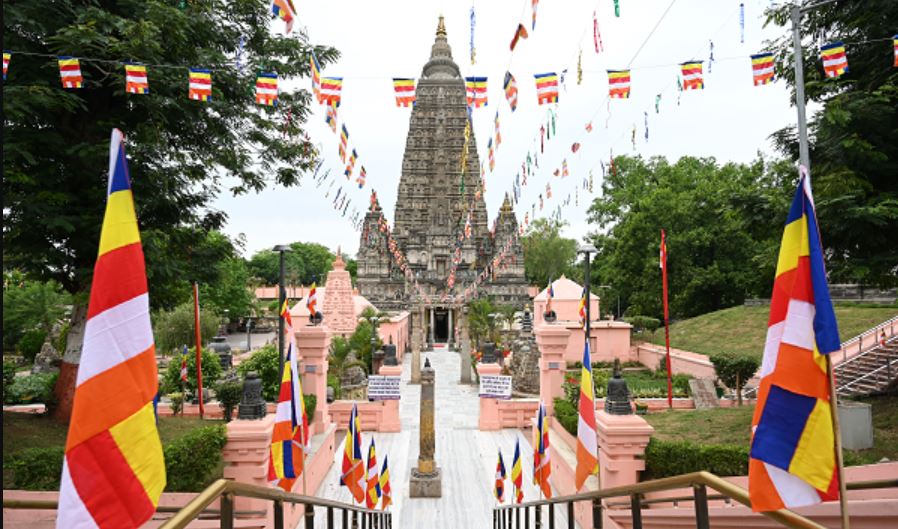A recent geospatial analysis, utilizing advanced satellite imagery and meticulous ground surveys, has unearthed compelling evidence of substantial architectural treasures concealed beneath Bihar’s iconic Mahabodhi temple complex. Managed by the Bihar Heritage Development Society (BHDS) in collaboration with Cardiff University, this revelation promises to redefine our understanding of the region’s rich cultural heritage.
Quest for Archaeological Marvels
The Mahabodhi temple complex, distinguished as a UNESCO World Heritage site and revered as one of the four sacred sites associated with Lord Gautam Buddha’s life, stands as a testament to centuries of spiritual significance. Situated in Bodh Gaya, where Lord Buddha attained enlightenment, the site has captivated historians and archaeologists alike.
“The study has unearthed evidence of the presence of archaeological treasure beneath the soil of the UNESCO World Heritage site and its surrounding areas… It’s a huge architectural wealth that needs further excavation,” remarked Harjot Kaur Bamhrah, Additional Chief Secretary of the Art, Culture, and Youth Department, in an exclusive interview with PTI.
Collaborative Insights: The Xuanzang Connection
The collaborative effort between BHDS and Cardiff University, under the project ‘Archaeology on the footsteps of the Chinese traveller Xuanzang’, has been pivotal. Xuanzang, a revered 7th-century Chinese monk and scholar, traversed from China to India, chronicling his journey that remains instrumental in understanding ancient Indian sites.
M.B. Rajni, a distinguished faculty member at Bengaluru’s National Institute of Advanced Studies and a key project contributor, meticulously analyzed satellite images. Her findings, correlating with Xuanzang’s historical descriptions, hint at an intricate network of buried structures north of the temple complex.
Reimagining Historical Boundaries
Of particular note are satellite images revealing significant historical shifts, including the westward movement of the river Niranjana. Historically, the Mahabodhi temple and adjacent Sujata Stupa shared a river bank, underscoring a shared historical landscape now redefined by modern geographical changes.
Bamhrah emphasized the significance: “This finding suggests that the monuments and archaeological remains east of the river, previously considered separate, may have been integral parts of the Mahabodhi complex.”
Future Prospects: Unveiling the Past
Buoyed by these revelations, BHDS plans to conduct extensive research to delineate the Mahabodhi complex’s boundaries accurately. This will include comprehensive ground-penetrating radar surveys followed by systematic excavations to unearth buried architectural features highlighted by satellite imagery.
Elaborating on the findings, BHDS Executive Director Bijoy Kumar Choudhary highlighted new discoveries north of the temple premises. These include traces of a square monastery complex enclosed by walls and a surrounding moat, underscoring the region’s archaeological richness awaiting further exploration.
Conclusion
The discovery beneath the Mahabodhi temple complex not only enriches our understanding of its historical significance but also underscores the need for meticulous preservation and exploration. As efforts continue to uncover the region’s hidden treasures, this revelation stands as a testament to India’s rich cultural tapestry and its enduring allure for scholars and spiritual seekers alike.
Summary:
This article delves into recent geospatial findings revealing significant archaeological treasures beneath Bodh Gaya’s Mahabodhi temple complex. Collaborative efforts between BHDS and Cardiff University highlight historical insights and future exploration prospects.
Key Learning Points:
| Learning Point | Details |
|---|---|
| Geospatial analysis uncovers buried architectural wealth | Satellite images and ground surveys reveal extensive structures beneath Mahabodhi temple. |
| Historical significance of Mahabodhi complex | A UNESCO World Heritage site, integral to Lord Gautam Buddha’s life, with profound spiritual significance. |
| Project ‘Archaeology on the footsteps of Xuanzang’ | Research initiative to explore connections based on the journey of the 7th-century Chinese monk. |
| Future research and excavation plans | BHDS plans ground-penetrating radar surveys and systematic excavations to unveil buried features. |
Soumya Smruti Sahoo is a seasoned journalist with extensive experience in both international and Indian news writing. With a sharp analytical mind and a dedication to uncovering the truth, Soumya has built a reputation for delivering in-depth, well-researched articles that provide readers with a clear understanding of complex global and domestic issues. Her work reflects a deep commitment to journalistic integrity, making her a trusted source for accurate and insightful news coverage.



